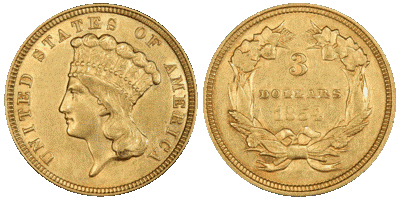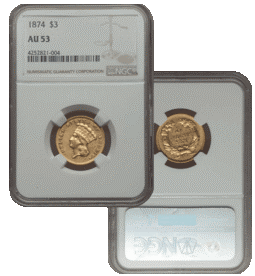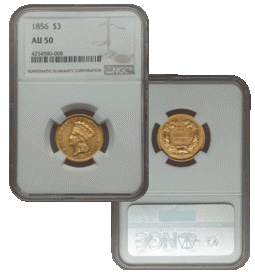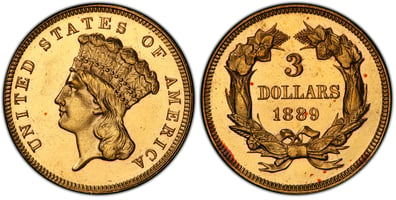After a phenomenal response from last month’s Twelve Caesars Gold Collection offering, we are now...
The Rarest U.S. Gold Coin Ever Circulated
The $3 gold piece is one of the scarcest and most fascinating U.S. gold coins. While the coin never gained acceptance with 19th century Americans, it has become a treasured collectible. Numismatists have always been drawn to the $3 “Princess” for its unusual denomination, extreme level of scarcity, and attractive design. This enigmatic coin ranks as one of the most illustrious rarities.
We’re always on the lookout for high-quality $3 Princesses. Not only are they intriguing coins, but we consider them an outstanding value. Few coins offer such a colorful backstory and a surprisingly affordable price point. Understandably, when one of our key sources brought us a diverse group of About Uncirculated $3 Princesses, we pounced at the opportunity!

History of the $3 Princess
The $3 Princess traces its roots back to 1845, when the federal government authorized the first postage stamps. The price per stamp was initially five cents, but this rate was considered too high. To spur stamp purchases, the unit price was lowered to three cents in 1851. The price reduction helped postage stamps gain traction with the public, and usage flourished in the early and mid-1850s.
As a further boon to the three-cent postage stamp, the U.S. Mint followed suit by issuing a three-cent silver coin. The idea was that having a coin of the same value would make stamp buying even easier. Americans seemed to embrace the concept and began using the new coin. Surprisingly, over 35 million three-cent silver coins were made from 1851 to 1853. The coin was extremely small and a bit difficult to handle, but seemed to enjoy decent success nonetheless.
Given the popularity of three cent stamps and their corresponding silver coins, politicians began contemplating a $3 gold coin. Not only would the coin help facilitate buying sheets of stamps, but bankers could also use them to trade for rolls of three-cent coins. Furthermore, there was a temporary surplus of gold flowing in from the California Gold Rush—and the Mint was looking for new ways to convert this gold into coinage.
Once Congress approved the new $3 gold piece in early 1853, U.S. Mint Chief Engraver James Longacre began working on the coin’s design. He faced an immediate challenge with the new denomination: differentiating it from the Quarter Eagle and Half Eagle. If he used the exact same motif, there was a risk that the $3 gold piece would be confused with the $2.50 or $5 coins.
To eliminate any potential confusion, Longacre made two key decisions. First, he decided that the coin should be large and flat. This would clearly differentiate it from the Quarter Eagle. Even though the $3 gold piece would be approximately the same size as the Half Eagle, it would display a completely different look. His design for the $3 gold piece showed an Indian princess on the obverse and a wreath of corn, wheat, cotton, and tobacco on the reverse.
 Production began in 1854 and started strong—over 30% of all $3 Princesses ever struck were minted in 1854. Unfortunately, these large mintages were the result of wishful thinking, not actual demand. The public largely rejected the coin, deeming it too similar in size to the Half Eagle. It has also been questioned whether the average American typically bought sheets of stamps—after all $3 was still a sizeable amount of money at the time. In the following years, mintages slumped tremendously, never to return to their 1854 levels.
Production began in 1854 and started strong—over 30% of all $3 Princesses ever struck were minted in 1854. Unfortunately, these large mintages were the result of wishful thinking, not actual demand. The public largely rejected the coin, deeming it too similar in size to the Half Eagle. It has also been questioned whether the average American typically bought sheets of stamps—after all $3 was still a sizeable amount of money at the time. In the following years, mintages slumped tremendously, never to return to their 1854 levels.
Despite the lukewarm reception, the Philadelphia Mint continued to produce $3 Princesses for another 35 years. Mintages were anemic—in many years fewer than 5,000 pieces were struck. Dies for the $3 Princess were sent to the branch mints repeatedly in the 1850s and 1860s, but they refused to strike the coins. Demand was so low that in 1875 and 1876, only a small number of proofs were made for collectors. No coins were made for circulation. According to mint records, 49,087 $3 Princesses were melted in the 1890's.
While the general public had little use for the coin, early coin dealers were already touting them as collectibles. Philadelphia-based firms would buy the coins at face value from the mint and sell them to collectors throughout the country. Since the coins were almost never seen in circulation, they had a novelty factor and traded for a premium outside of Philadelphia. The $3 Princess was also a popular component in jewelry. Today, many surviving specimens show evidence of mounting, solder, and polishing.
Finally, in 1889, the $3 Princess was quietly discontinued with a paltry mintage of 2,300 pieces that year. Now officially obsolete, the coin’s value as a collectible began to climb. In the 1920s, for example, most 19th century gold coins were only worth face value, but $3 Princesses were already trading for sizeable premiums. U.S. gold coin collecting was still in its infancy, but the $3 Princess was one of the first items to be actively pursued by numismatists.
 It Doesn’t Get Much Rarer Than This…
It Doesn’t Get Much Rarer Than This…
Simply put, the $3 Princess is the rarest U.S. gold coin made for circulation. Most U.S. gold coin series have common and scarce issues, but every $3 date is considered rare. Over 36 years of production, only 538,174 pieces were struck. To put this in perspective, 538,174 coins might have represented a month’s worth of $5 gold coin production during that same era. Furthermore, the mintages only tell half the story, as a substantial percentage of $3 Princesses were later melted.
The lion’s share of $3 Princesses shows mild circulation and/or signs of jewelry use. Grades of Very Fine and Extremely Fine are most frequently encountered. For example, the unique 1870-S $3 Princess (estimated to be worth several million dollars) is Extremely Fine with light cleaning, engraving, and evidence of having been mounted. Problem-free About Uncirculated $3 Princesses are very scarce and represent the minority of all survivors.
Choose Only the Best
The group of $3 Princesses we have today is unusual in two respects. First, each and every coin is graded About Uncirculated (AU) 50 or finer by PCGS or NGC. This means each coin is problem-free and shows just minor signs of wear. In fact, the specimens still show some traces of original mint luster. Secondly, and perhaps most importantly, there is an incredible assortment of dates. When we see $3 gold pieces on the market, they are almost always just one or two different dates. This group has a remarkable variety, which allows us to offer you a guaranteed mix:
|
Quantity Ordered |
Price |
You’re Guaranteed |
|
1 |
$1,249 per coin* plus |
One date |
|
3 |
$1,239 per coin* plus |
Three different dates with one date guaranteed from the California Gold Rush era (1854–1859) |
|
5+ |
$1,229 per coin* plus |
Five different dates with two dates guaranteed from the California Gold Rush era (1854–1859) |
This represents a rare opportunity to own an instant mini-collection of $3 Princesses. Not only can you own this fascinating and enigmatic coin for less than $1,300, but you’re also guaranteed a wide assortment of dates. When we discovered that some of the coins were struck during the California Gold Rush, we were even more excited about this group! Our only caveat is that just 40 coins are available, with an extremely limited quantity of multi-date sets. In fact, we have just 4 of the complete 5-coin sets available—so don’t wait long to secure these intriguing sets!
If you want to take advantage of this offer, we strongly urge you to do so now. Given the highly unusual nature of this mini-hoard—and the special guaranteed date mix—we do not expect these coins to last long. To secure your pristine $3 Princesses today, please call us at 800-831-0007 or email us.
*Prices subject to change based on market fluctuation and product availability. Prices reflected are for cash, check, or bank wire. Free shipping, handling, and insurance are available for all quantities ordered. Offer expires Friday, November 2, 2018, or while supplies last.




